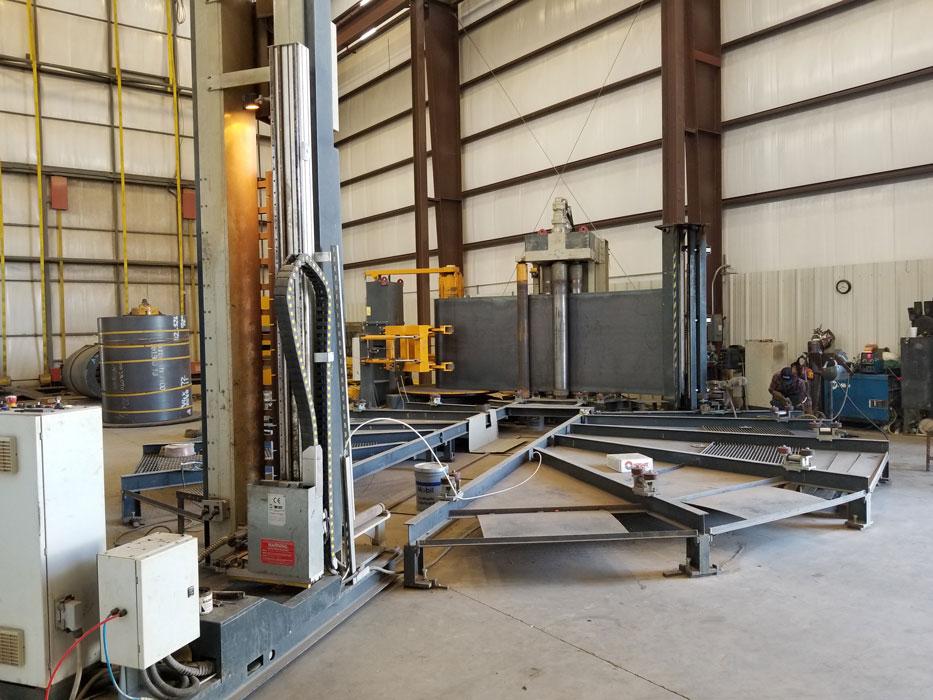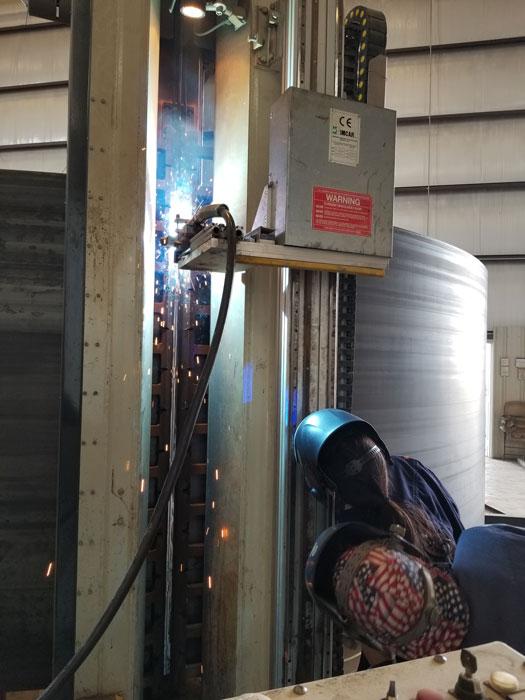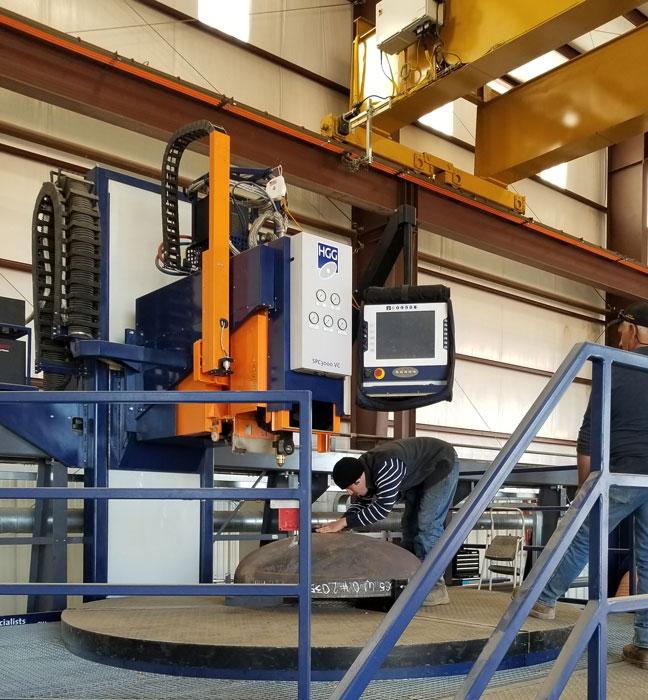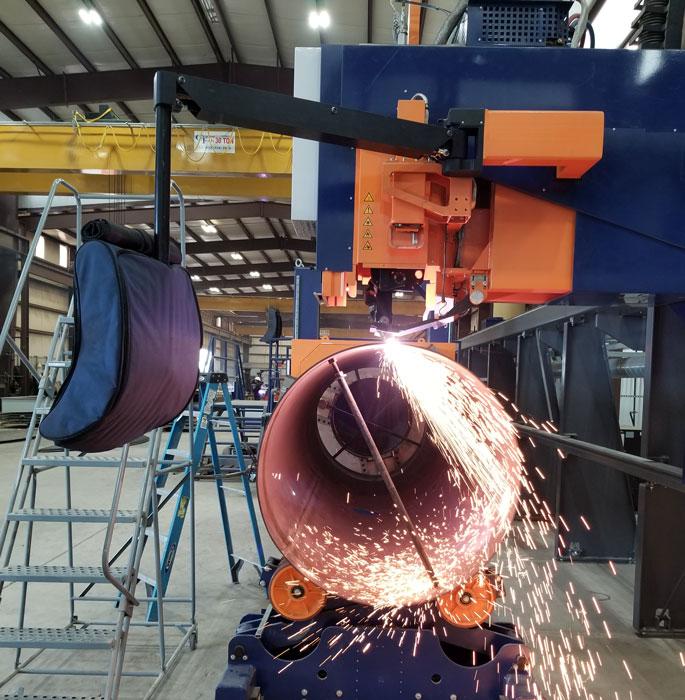Senior Editor
- FMA
- The Fabricator
- FABTECH
- Canadian Metalworking
Categories
- Additive Manufacturing
- Aluminum Welding
- Arc Welding
- Assembly and Joining
- Automation and Robotics
- Bending and Forming
- Consumables
- Cutting and Weld Prep
- Electric Vehicles
- En Español
- Finishing
- Hydroforming
- Laser Cutting
- Laser Welding
- Machining
- Manufacturing Software
- Materials Handling
- Metals/Materials
- Oxyfuel Cutting
- Plasma Cutting
- Power Tools
- Punching and Other Holemaking
- Roll Forming
- Safety
- Sawing
- Shearing
- Shop Management
- Testing and Measuring
- Tube and Pipe Fabrication
- Tube and Pipe Production
- Waterjet Cutting
Industry Directory
Webcasts
Podcasts
FAB 40
Advertise
Subscribe
Account Login
Search
The next generation of vessel and tank production
Texas shop invests in automated vertical rolling, profile cutting, and more
- By Tim Heston
- March 1, 2018
- Article
- Bending and Forming

A rolled tank shell at Smith Industries, created with a coil-fed vertical rolling system, is lifted and moved for further processing.
When Chris Smith joined his father’s company eight years ago, he didn’t know he’d be leading the organization in 2018, but so it goes. After his father’s illness and passing in early 2017, Smith took the helm of Smith Industries, a 200-plus-employee tank and vessel fabricator in Midland, Texas, in the heart of the Permian Basin.
Smith is leading the fabricator through changes his father Rick Smith set in motion more than six years ago. In the vessel shop at that time, one saw technicians marking cutouts with chalk and cutting them manually, a method practiced around the Permian Basin for decades.
Today many welding and cutting processes at Smith Industries are automated, including that laborious cutting of profiles on the heads and shells of vessels. When it comes to tank production, technicians need not spend time positioning sheet in front of a plate roll, either. Instead, material, most of which is 3/16-in.-thick carbon steel, is fed into a vertical roll—directly from a coil.
Coil-fed vertical rolling technology isn’t new. Machines started appearing on the world market more than a decade ago, and Smith Industries installed its first system more than six years ago (the fabricator now has two). And the fabricator isn’t the only one in the oil and gas industry to use one.
Regardless, automaton in general represents just one piece of the puzzle to Smith Industries’ recent success and, perhaps most important in the Permian Basin, its ability to weather the ups and downs of the oil and gas market. An openness to technology is part of it, but so is a dedication to training. Another piece of it is a constant scrutiny of overall work flow. Smith Industries does it all.
How the Business Evolved
In the early 2000s Rick Smith and his two brothers owned Smith Brothers Pipe, a distributor that sold process piping and related equipment to oil drilling operations. In doing so, the company worked closely with fabricators of surface production equipment. That’s oil industry lingo for equipment at the drill site that handles, heats, separates, processes, and stores oil, water, and other drilling byproducts after the rig leaves and oil and gas start to flow. A big part of all this are pressure vessels and storage tanks.
“My dad had good relationships with [drilling companies] around the Permian. And in the early 2000s he was having trouble getting service production equipment,” Chris said. “At the time there were only a few suppliers in the business. My dad saw the demand, and he had friends in the [oil] business who needed equipment.”
Smith Industries got into fabrication slowly. During the early days, the company outsourced about 70 percent of fabrication. But as everyone knows, oil is a business of ups and downs, and during the downturn in the early 2000s, Rick found that it no longer made business sense to outsource so extensively.
“There just wasn’t room on the margin side to outsource,” Chris said. “So dad started to add buildings.” Chris paused, then glanced over at his co-worker sitting beside him. “And he brought on Joe to oversee a lot of the processes and automation.”
Joe Smith (no relation) is the fabricator’s quality control and special projects manager, and he can also put a lot of initials after his name. He’s certified to teach American Society of Mechanical Engineers (ASME) standards for the company’s pressure vessel work, as well as the American Petroleum Institute (API) standard for storage tank fabrication. He’s also an American Welding Society (AWS) certified welding inspector (CWI), certified welding supervisor (CWS), and certified welding educator (CWE).
Growth Through Automation
Joe Smith joined the company six years ago. From the start he began focusing on freeing bottlenecks and, ultimately, helping the Smith family build a sustainable business that would be tough enough to weather the booms and busts in the oilfields. Enduring those booms and busts really wasn’t an option. The company’s location in the heart of oil country, and the unique processes that the oil and gas business requires, meant that diversification outside the oilfields really didn’t make sense.
Smith Industries was and will remain a reliable producer of surface production equipment, able to deliver just what customers need, when they need it. And what customers need now is extraordinarily varied. A fabricator who worked in Permian Basin tank and vessel production two decades ago probably wouldn’t recognize a lot of the work being produced on Smith Industries’ shop floor today.
“Back in the day, it was all vertical drilling and vertical wells,” Chris recalled. “Every [drill operator] basically ordered the same equipment.” One company’s storage tank pretty much looked like everybody else’s oil tank.
Fracking and the horizontal drilling that came with it changed everything. As Chris explained, “We now have all horizontal wells. The [tanks and vessels] hold much higher volumes, and everything needs to handle a lot more fluid.” He added that surface production equipment is larger, engineered, and optimized for the application.
Such variation might seem like it would make the situation more difficult for automation. But modern automation is flexible. A roll can be programmed to run a variety of diameters. And Smith Industries’ CNC multiaxis profile cutter from HGG, which has both plasma and oxyfuel torches, can read information postprocessed from CAD files.
Such automation technology is designed for custom work. Installed in 2017, the profiler represents Smith’s latest automation investment. “We used to lay out [the cutouts in the pressure vessels] by hand,” Joe recalled. “They had to cut it and then hand bevel and grind the edges. The automation allowed us to go from a two-day process to a two-hour process.”
Rolling Vertical
Smith Industries uses the profiler exclusively for its pressure vessel production, which employs traditional (horizontal) plate rolls. Most vessels are made of material that’s between 1/2 and 5/8 in. thick, but a few are ¾ in. and thicker.
The walls of tank shells, however, are thinner. A few go up to ¼ in. thick, but most are 3/16 in., and most are rolled to a large diameter. Tank shells are typically 15 ft. 6 in. or 21 ft. 6 in. wide. And unlike rolling thick material, rolling thin material to such a wide radius requires no prebending.
If the fabricator were rolling horizontally in a conventional manner, rolling such thin material to such large diameters would present challenges. The loaded sheet would be extremely long, and as the roller kept rolling, the resulting shell would bow under its own weight. Sure, the roller could have an overhead support to guide the material and prevent bowing. And after rolling, the shell could be tack-welded to an alignment ring to keep the shape true while sitting horizontally. But why fight gravity? Why go through the trouble of working on a tank positioned horizontally? As Joe explained, this is why coil-fed vertical rolling makes so much sense for tank production.
“Coil-fed rolling generally works for material up to ½ in. thick, and that’s on the high side,” said Jeremiah Weekley, vice president of Judson, Texas-based Fabrication Solutions & Technologies, an IMCAR Co. “Traditionally, material up to 3/8 in. thick can be a coil application.” He added that in the U.S. many vertical rolls have been used for carbon steel, primarily because of demand in the oil and gas industry, but the technology is highly prevalent in the stainless tank fabrication industry as well.
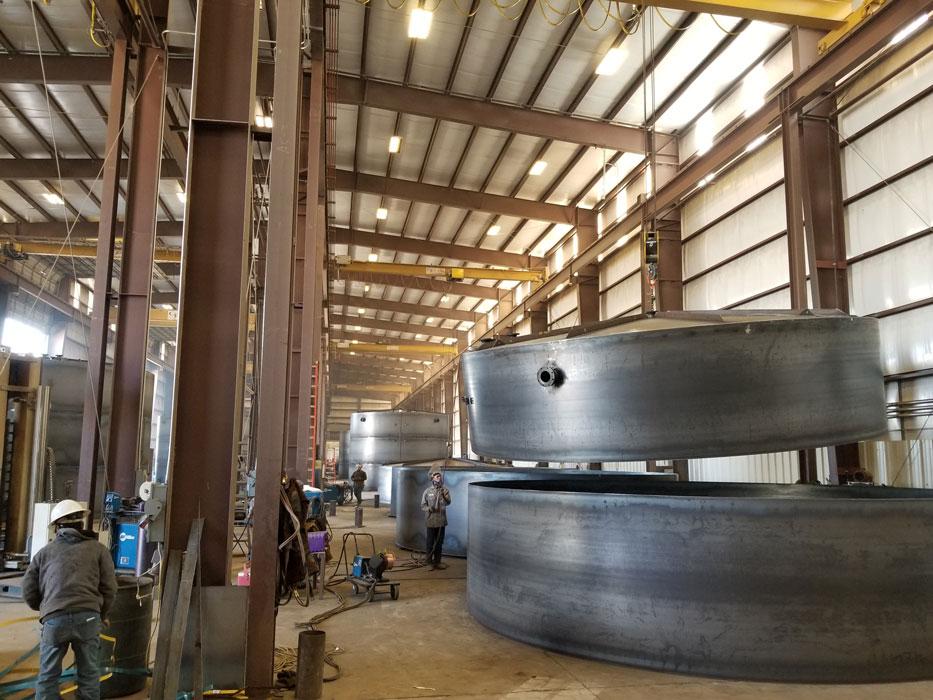
In January tank shells are placed on top of one another, after which the girth joint is gas metal arc welded. As of February, the company has automated this girth welding process.
At Smith Industries, tanks are assembled and operate in their vertical orientation, so rolling them vertically eliminates a lot of arduous material handling. It’s also a lot easier to handle a coil rather than a large, long sheet.
Smith does need significant crane capacity to lift and move coils into position, ready for the vertical rolling system, provided by IMCAR. Smith’s overhead cranes move 44,000-lb. coils and set them on their side, onto a vertical decoiler. Once the coils are on the decoiler, though, material handling requirements become easy, at least when compared to fabricating a tank horizontally.
The coil is fed through the decoiler and through the rolls, programmed to form a tank of a certain thickness to a certain radius and diameter. The automated rolling systems have two stations, called Station 1 and Station 2. In Station 1, the coil is fed into the vertical rolls and forms until the shell completes a circumference, at which point an adjacent (also vertical) plasma station cuts the coil edge. The decoiler and rolls then move back several feet to allow room for technicians to clean and tack-weld the edges, creating the initial shell form.
At this point the tank shell is rotated to the vertical seam welder incorporated in Station 1. There, the shell is clamped and a system with a remote operator interface welds the vertical seam. In the typical 3/16-in.-thick shell, a gas metal arc welding system from Miller Electric welds the vertical seam (which is a simple butt joint configuration) with a backing bar. But the shop has used the vertical rolls to process material up to ¼ in. thick, too, which requires a little weld joint prep. “In these cases, we take a grinder, clean up the joint, and run down the joint line to produce a groove that’s about 50 percent of the material thickness,” Joe said.
If the shell will become the top section of a tank, the head or deck is tacked in place and welded with a carriage or tractor system. After this, the completed shell is then removed.
These tanks are tall, so they usually require three shell sections to be stacked on top of one another (though this can vary depending on the tank design). In February the shop installed Station 2, which automates the girth welding. So now a shell is rolled and welded in the first station, then moved to Station 2, where it is stacked on top of another shell.
Station 2 has rigid columns connected to a hydraulic alignment system that rotates the workpieces. “The operator tack welds as the shells feed into the alignment system,” Weekley said. “Once the welder sees the beginning of his tack weld sequence, he knows the shells have made a complete rotation. At that point the operator pushes a button, which starts the welding of the circumferential seam.” He added that the girth weld seam is completed using a special dual-head GMAW process from Fronius.
Weekley added that, depending on the application requirements, an operation can then use the rolls in the hydraulic alignment system to planish the weld. “This is very common when rolling stainless, but it’s not as common with the carbon steel used in the oil industry.” Smith Industries usually doesn’t planish the girth welds, but its system does have that functionality, should the need arise.
After removing the tank section from the second station, technicians then weld the tank bottoms—again, not by hand but by a carriage (or tractor) system that travels around the shell circumference. “The tank is sitting vertically while the tractor on the floor of the tank runs around the diameter,” Joe said. “There are no stops and starts, and that increases our efficiency.”
Coil Considerations
Stopping is rare these days, but when it happens, it’s usually because of a bad coil. “We’ve returned a few coils,” Joe said, adding that the rolls can work out coil shape defects. “We can eliminate those defects by rolling it three or more times,” he said. “But we don’t have time for that. If we do have a bad coil, we just return it.” He added, though, that the company has worked well with its material suppliers, and receiving bad coil doesn’t happen often.
Weekley added that because these shells are stacked and welded, Smith Industries (along with others in the Permian) buy slit-edge coil. “Rather than cutting it into plate and squaring the edges, the material supplier squares the edges of the entire coil. This means the edge runs true and you get a more accurate finish. This makes it a lot better for the downstream processes of fit-up, alignment, and welding.”
Regardless, Weekley said that if a fabricator does perform coil-fed rolling, coil quality is key. “It’s fair to say that you do need to work with quality coil. If you look overseas and buy the lowest-cost material you can find, it’s probably not going to work as well as it would with quality material.”
Chasing the Bottleneck
As of January, even without Station 2 fully implemented, Smith Industries’ two vertical rolling systems were producing as many as 30 rolled shells, each 15 ft. 6 in. in diameter, in just one shift. “Because each tank usually requires three shells, that’s about 10 tanks,” Joe said.
The company’s quest for greater efficiency hasn’t stopped. After all, when one bottleneck is cleared, like in rolling, another one emerges. “Right now our next bottleneck is in blasting and painting,” Joe said.
Today operators must navigate up and down scaffolds to blast and coat massive tanks. As Joe explained, the company is investing in automated platforms that can carry blasting and paint operators up and down as the large tank or vessel rotates in front of them. “It’s like a rotisserie,” Joe said, adding that the platforms will come complete with turrets where workers can mount their blasting and paint guns—good for efficiency as well as ergonomics.
Smith Industries continues to expand, building a separate facility dedicated to vessel production. The area in the main building, where pressure vessels are produced now, will become a parts fabrication space that will support both tank and vessel fabrication and assembly.
The company is also reconsidering its purchasing strategy, particularly when it comes to tank and pressure vessel heads. Specifically, it’s exploring ways to keep a separate warehouse and ordering heads in greater volumes, so the company can respond swiftly when needed.
About Talent
Automation doesn’t run without people. To that end, Smith Industries has its own training facility, and Joe Smith is its chief instructor. He teaches the basics of machine operation and, most significantly, the knowledge people need to weld in the oil business. The company has less shielded metal arc welding than it did. Most welding is either submerged arc welding or gas metal arc welding using metal-cored wire.
Welders need to be certified to API and ASME standards. Joe trains welders individually or in groups of four or five and conducts testing. The fabricator is also reaching out to community colleges and training centers in the region. But will this be enough?
“We grew 25 percent in 2017,” Chris said, “and we are hoping for another 25 to 30 percent bump in revenue in 2018.”
At this writing the company has a backlog of orders through the end of 2018, a clear sign that the boom times have returned to the oil patch. What will hold the company back from growing even more? Chris’ answer probably sounds familiar. “We see some tremendous growth ahead, if we can find the employees to support it.”
The labor shortage isn’t as dire as it was during the oil boom five years ago. Still, the issue is starting to rear its ugly head yet again. Regardless, with progressive investment in automation, Smith Industries has certainly given its employees the tools they need to compete. No doubt, it’s an operation that would have made Chris’ father proud.
Photos courtesy of Smith Industries, www.smithindustriestx.com.
Fabrication Solutions & Technologies, an IMCAR Co., www.fststeelfab.com
Fronius USA, www.fronius.us
HGG Group, www.hgg-group.com
Miller Electric, www.millerwelds.com
About the Author

Tim Heston
2135 Point Blvd
Elgin, IL 60123
815-381-1314
Tim Heston, The Fabricator's senior editor, has covered the metal fabrication industry since 1998, starting his career at the American Welding Society's Welding Journal. Since then he has covered the full range of metal fabrication processes, from stamping, bending, and cutting to grinding and polishing. He joined The Fabricator's staff in October 2007.
Related Companies
subscribe now

The Fabricator is North America's leading magazine for the metal forming and fabricating industry. The magazine delivers the news, technical articles, and case histories that enable fabricators to do their jobs more efficiently. The Fabricator has served the industry since 1970.
start your free subscription- Stay connected from anywhere

Easily access valuable industry resources now with full access to the digital edition of The Fabricator.

Easily access valuable industry resources now with full access to the digital edition of The Welder.

Easily access valuable industry resources now with full access to the digital edition of The Tube and Pipe Journal.
- Podcasting
- Podcast:
- The Fabricator Podcast
- Published:
- 04/16/2024
- Running Time:
- 63:29
In this episode of The Fabricator Podcast, Caleb Chamberlain, co-founder and CEO of OSH Cut, discusses his company’s...
- Trending Articles
AI, machine learning, and the future of metal fabrication

Employee ownership: The best way to ensure engagement

Steel industry reacts to Nucor’s new weekly published HRC price

Dynamic Metal blossoms with each passing year

Metal fabrication management: A guide for new supervisors

- Industry Events
16th Annual Safety Conference
- April 30 - May 1, 2024
- Elgin,
Pipe and Tube Conference
- May 21 - 22, 2024
- Omaha, NE
World-Class Roll Forming Workshop
- June 5 - 6, 2024
- Louisville, KY
Advanced Laser Application Workshop
- June 25 - 27, 2024
- Novi, MI
























